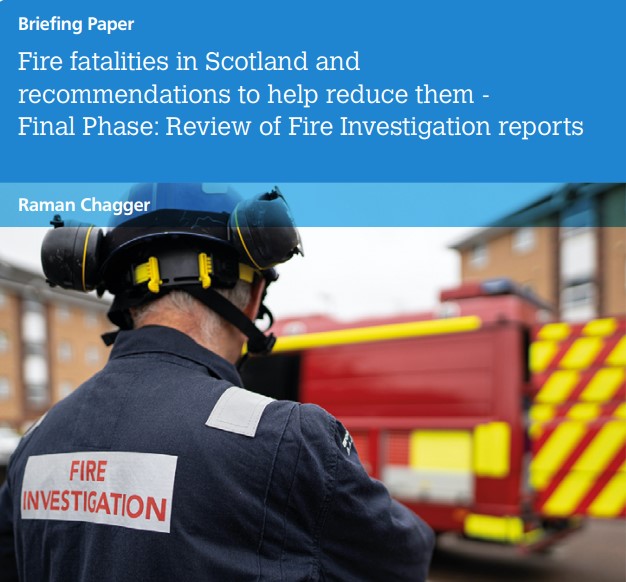Fire fatalities in Scotland
Contents |
[edit] Introduction
The research entitled Fire fatalities in Scotland and recommendations to help reduce them – Final Phase: Review of Fire Investigation reports has led to a number of recommendations that, if implemented, would be expected to result in a reduction in fire fatalities.
[edit] Investigative reports
This final phase of collaborative research study investigating fire fatalities in domestic dwellings in Scotland involved a comprehensive qualitative and quantitative review of Fire Investigation reports. The reports, generated from 126 fires over a four-year period, were produced and supplied by Scottish Fire and Rescue Service (SFRS).
The stakeholder group, comprising the Fire Industry Association, SFRS, Scottish Government and BRE Global, reviewed the Fire Investigation reports. A number of recommendations have resulted that are aimed at different groups including care package suppliers, manufacturers of electronic equipment, public services (NHS, carers, social workers, police, SFRS), the general public and researchers.
[edit] Greater role for technology
The findings demonstrate that whilst new and emerging technologies may provide additional protection in the future, the greater use of existing technologies could be applied immediately and would be expected to save lives. Some of these include providing inter-linked smoke alarms in bedrooms and living spaces, the greater use of the certified watermist systems and greater communication of agencies, neighbours and relatives with the SFRS when an at-risk person has been identified.
Two key areas for warranting further research were proposed which were an experimental investigation of the common electrical items involved in starting fires and a demonstration of the effectiveness of current approved suppression strategies.
The briefing paper ends with an example concept strategy intended for Fire and Rescue Services to assist with the risk classification of vulnerable individuals and proposes solutions that would provide appropriate levels of life safety protection. The findings may be of use to fire and rescue services generally to enable them to identify vulnerable people most at risk and propose interventions to protect them.
BRE Global are exploring opportunities for performing similar collaborative studies in other countries.
This article originally appeared under the headline, "Fire fatalities in Scotland and recommendations to help reduce them – Final Phase: Review of Fire Investigation reports." It was posted in December 2020.
[edit] Related articles on Designing Buildings Wiki
- BRE articles on Designing Buildings Wiki.
- Building safety in Wales.
- Fire and rescue service.
- Fire in buildings.
- Fire safety design.
- Fire (Scotland) Act 2005.
- Interlinked fire alarm safety laws in Scotland.
- Ionisation smoke alarm.
- Multi-sensor alarm.
- New standards for better fire safety in homes.
- Optical smoke alarm.
- Scottish Advice Note addresses fire risk in multi-storey residential buildings.
- Scottish building standards.
- Scottish planning and architecture documents.
- Smoke detector.
- The Regulatory Reform (Fire Safety) Order 2005.
[edit] External resources
Featured articles and news
RTPI leader to become new CIOB Chief Executive Officer
Dr Victoria Hills MRTPI, FICE to take over after Caroline Gumble’s departure.
Social and affordable housing, a long term plan for delivery
The “Delivering a Decade of Renewal for Social and Affordable Housing” strategy sets out future path.
A change to adoptive architecture
Effects of global weather warming on architectural detailing, material choice and human interaction.
The proposed publicly owned and backed subsidiary of Homes England, to facilitate new homes.
How big is the problem and what can we do to mitigate the effects?
Overheating guidance and tools for building designers
A number of cool guides to help with the heat.
The UK's Modern Industrial Strategy: A 10 year plan
Previous consultation criticism, current key elements and general support with some persisting reservations.
Building Safety Regulator reforms
New roles, new staff and a new fast track service pave the way for a single construction regulator.
Architectural Technologist CPDs and Communications
CIAT CPD… and how you can do it!
Cooling centres and cool spaces
Managing extreme heat in cities by directing the public to places for heat stress relief and water sources.
Winter gardens: A brief history and warm variations
Extending the season with glass in different forms and terms.
Restoring Great Yarmouth's Winter Gardens
Transforming one of the least sustainable constructions imaginable.
Construction Skills Mission Board launch sector drive
Newly formed government and industry collaboration set strategy for recruiting an additional 100,000 construction workers a year.
New Architects Code comes into effect in September 2025
ARB Architects Code of Conduct and Practice available with ongoing consultation regarding guidance.
Welsh Skills Body (Medr) launches ambitious plan
The new skills body brings together funding and regulation of tertiary education and research for the devolved nation.
Paul Gandy FCIOB announced as next CIOB President
Former Tilbury Douglas CEO takes helm.
UK Infrastructure: A 10 Year Strategy. In brief with reactions
With the National Infrastructure and Service Transformation Authority (NISTA).
























